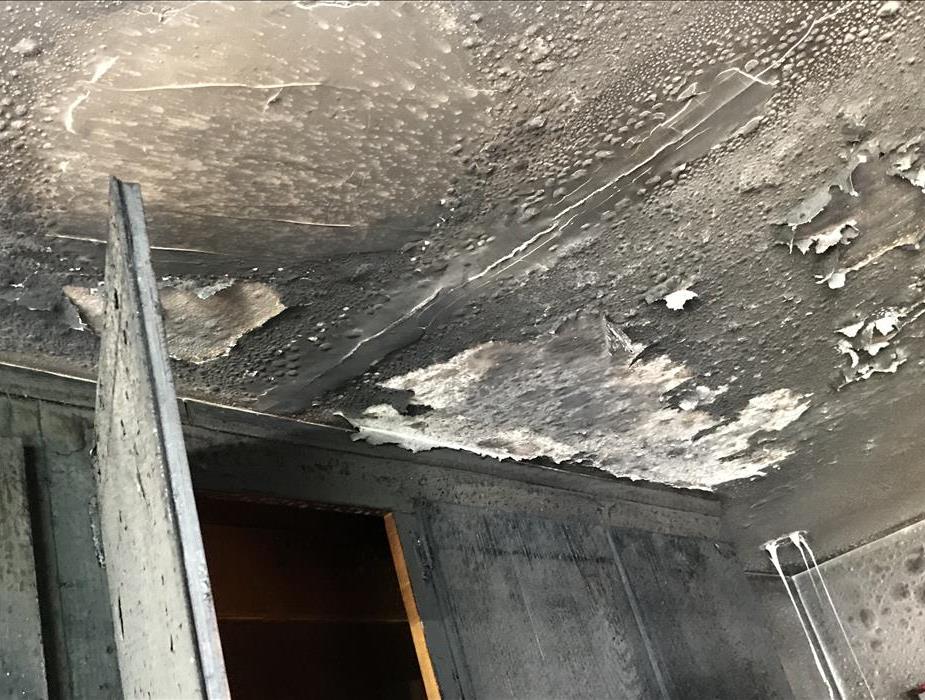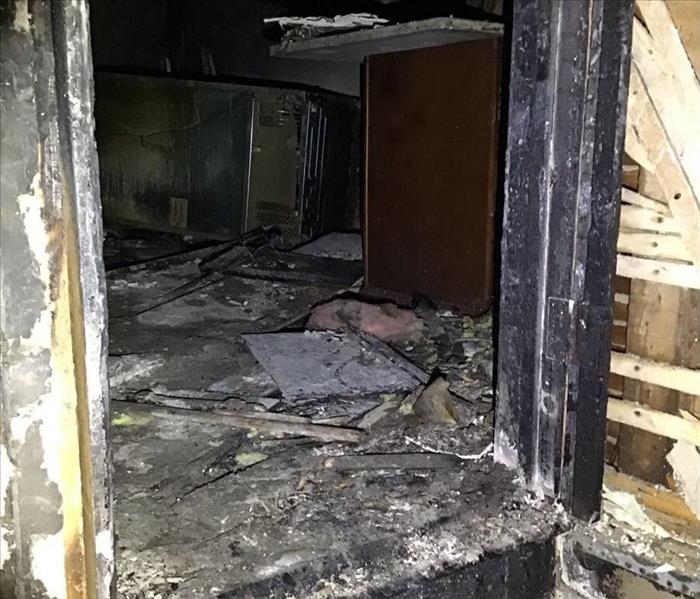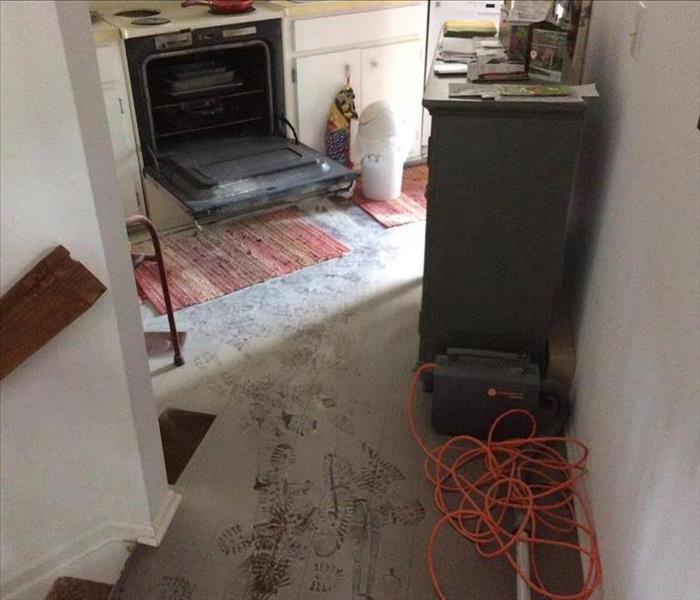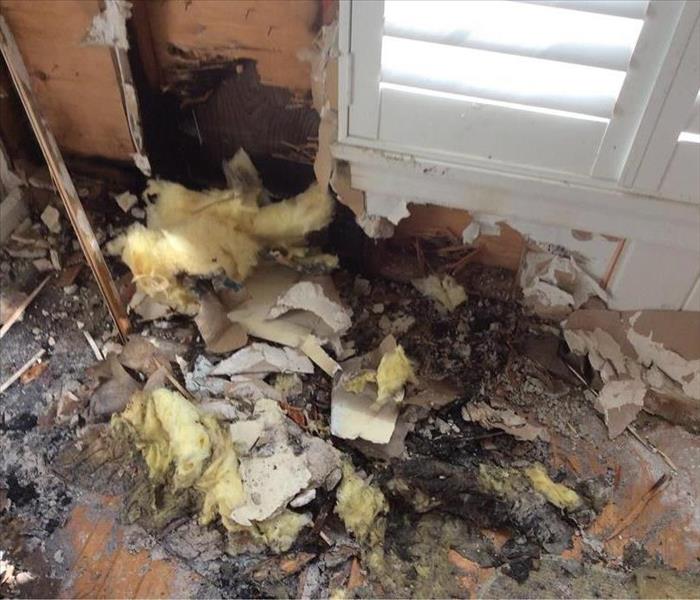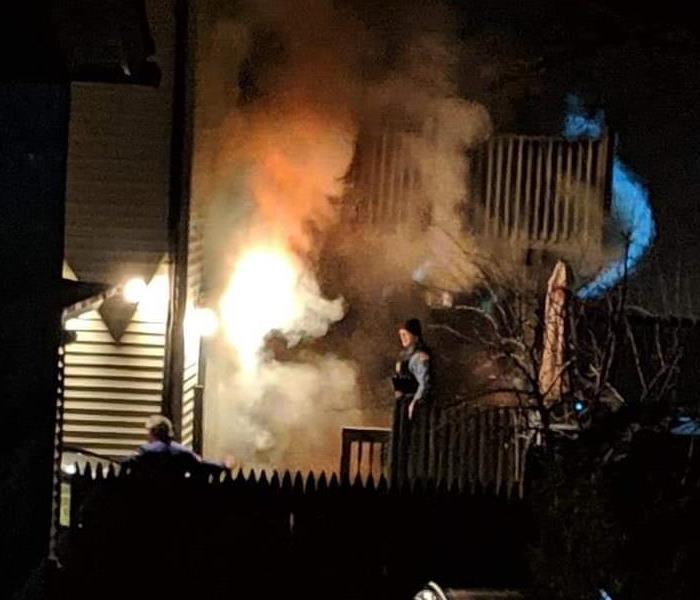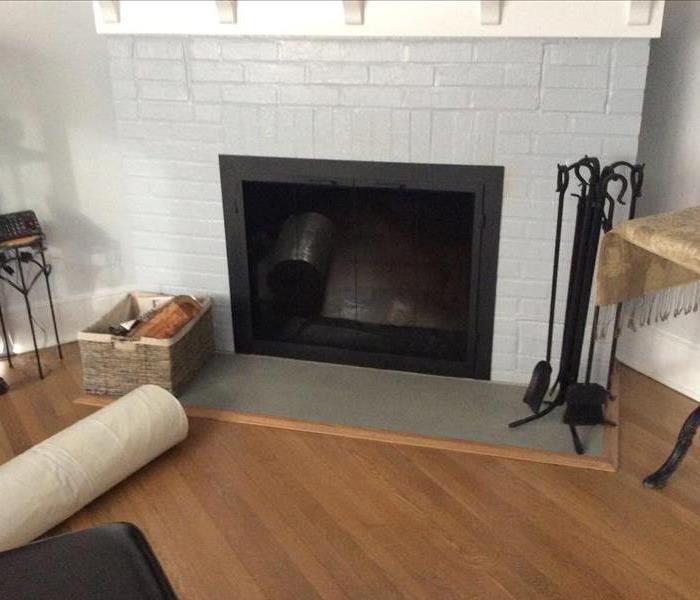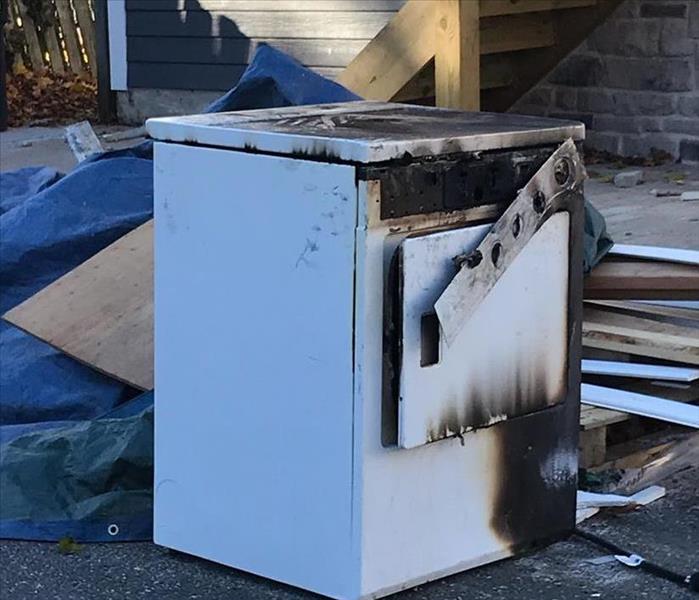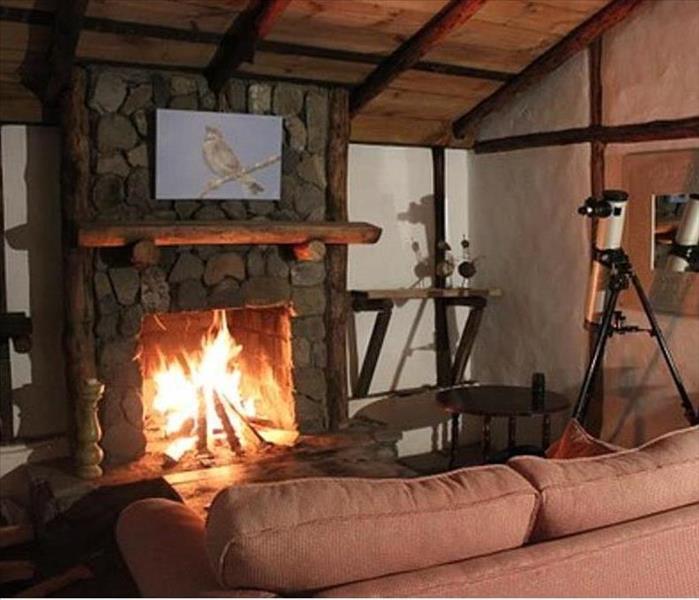Recent Fire Damage Posts
How to use a Fire Extinguisher
3/31/2022 (Permalink)
 A close-up photo of a fire extinguisher handle.
A close-up photo of a fire extinguisher handle.
In a prior blog, we discussed the acronym R.A.C.E. which represents the steps to take in care of a fire. Those steps are Rescue, Alarm, Contain, and Extinguish. Another acronym used in training for a fire response is P.A.S.S. which stands for Pull, Aim, Squeeze, and Sweep. These are the steps for using a fire extinguisher.
First, you want to make sure you have the correct fire extinguisher. In most settings, an ABC class extinguisher is most common. An ABC extinguisher puts out most fires including:
Class A fires – common materials including wood which typically produce Ashes.
Class B fires – flammable liquids that are typically stored in a Barrel, such as gasoline.
Class C fires – electrical fires that have an electrical Current
Fires that require a more specialized type of extinguisher include class D fires which are flammable metal or class K fires which are high temperature cooking oil fires.
The steps for using a fire extinguisher are:
P: Pull the pin that prevents the extinguisher from discharging accidentally.
A: Aim the nozzle at the base of the fire
S: Squeeze the handle/trigger to discharge the extinguishing agent
S: Sweep the nozzle back and forth to cover the burning material
What to do in case of a fire
3/30/2022 (Permalink)
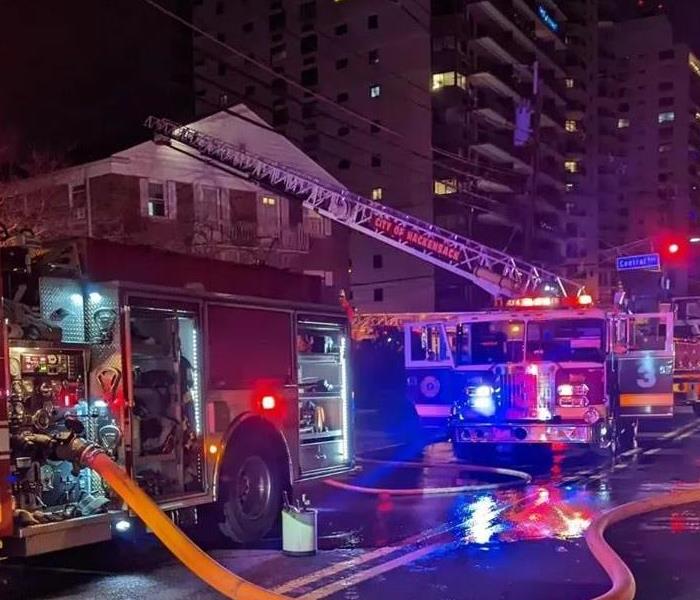 The Hackensack, NJ Fire Department in action.
The Hackensack, NJ Fire Department in action.
What should you do if you encounter a fire in your home or business? The common acronym R.A.C.E. provides some helpful guidelines. This stands for Rescue, Alarm, Contain, and Extinguish. These are the priority actions that should be taken. Unfortunately, they are often not followed in a panic as people typically try to fight the fire themselves, which costs precious time.
Rescue – The priority is life safety. Smoke and other deadly products of combustion can incapacitate an individual with just a few breaths. The top priority is rescuing anyone who is in personal danger.
Alarm – Sound the alarm by hitting the fire button on your alarm system or calling 911. A fire doubles in size every 45 seconds so alerting the fire department to begin their response is your second priority.
Contain – Stopping the spread of the fire is even more important than trying to extinguish the fire. Closing doors is a simple and effective way of stabilizing the scene and limiting fire spread. Moving a car away from a burning shed or using a garden hose to spray the vinyl siding next to a grill fire can likewise stop the fire from spreading and causing significantly more damage. All of these actions should only be attempted if they can be done safely.
Extinguish – Only after the first three actions have been completed should you attempt to extinguish the fire. Again, only if it can be done safely. Keep in mind that different types of fires (electrical, grease, gas-fed) may require special techniques to extinguish. At a minimum, every home and business should have an ABC class fire extinguisher handy as this is the most versatile type of extinguisher.
Of course, once the fire is extinguished, call SERVPRO because a quick response and immediate action can reduce the extent of smoke, water, and other damage.
Preventing Workplace Fires
2/27/2022 (Permalink)
 Firefighters battle a heavy fire in a commercial building.
Firefighters battle a heavy fire in a commercial building.
Fire Safety in the workplace is important all year round and our team here at SERVPRO of Hackensack/Little Ferry would like to review workplace fire prevention & safety.
Here is a top-10 of tips to ensure a fire-safe workplace:
Step 1. Get Organized– Practice good workplace housekeeping. Clutter contributes to fires by providing fuel and by preventing access to exits and emergency equipment.
Step 2. Designated Smoking Areas – Smoke only in designated areas and extinguish smoking materials safely. Never smoke in storerooms or chemical storage areas.
Step 3. Fire Extinguishers – Maintaining the appropriate type and number of fire extinguishers and learning how to properly use a fire extinguisher.
Step 4. Electrical Hazards – Report all electrical hazards. Many fires start in faulty wiring and malfunctioning electrical equipment.
Step 5. Access to Control Panels – Electrical control panels need to have free access maintained so that the electricity could be shut off easily.
Step 6. Sprinkler Systems & Smoke Detectors – Never block sprinklers, firefighting equipment, or emergency exits. Observe clearances when stacking materials. Test sprinkler systems and smoke detectors at least annually.
Step 7. Chemical Safety – Use and store chemicals safely. Read the label and the Safety Data Sheet to determine flammability and other fire hazards. Provide adequate ventilation when using and storing these substances.
Step 8. Waste Control & Storage – Control the accumulations of flammable and combustible waste materials and residues so that they do not contribute to a fire emergency.
Step 9. Exits – Emergency exit diagrams should be posted and emergency exits should be well lit with neon-regulation signs.
Step 10. Contact Info – Employees should have a list of emergency contact phone numbers in case of emergency. Remember that people will often panic in an intense situation; therefore basics such as the company address, phone number, and floor plan should be posted. The SERVPRO Emergency Ready Plan app is a great tool for collecting, storing, and sharing this information.
For additional information or a free consultation, please call us today.
Smoke Damage Requires Professional Help
1/31/2022 (Permalink)
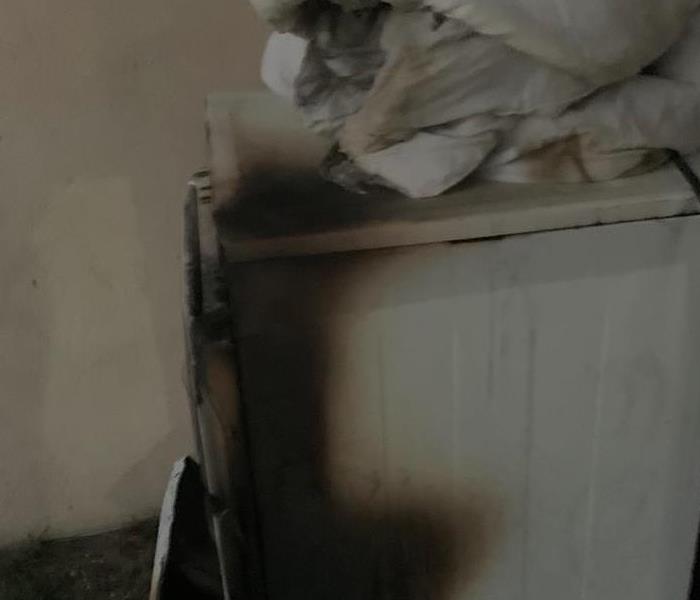 The aftermath of a dryer fire in NJ.
The aftermath of a dryer fire in NJ.
Smoke damage can make your home a dirty, smelling mess. Whether you’ve suffered a major fire catastrophe or had smoke damage accumulate from the presence of fire in your home, you want to start cleaning up smoke stains as soon as you can in order to prevent permanent damage.
Our team at SERVPRO of Hackensack/Little Ferry has seen our share of fire incidents as Professional Cleaning and Restoration Leaders in this community so, we know what smoke damage can do to a home.
Make Sure the Area is Safe
If your incident was a small kitchen grease fire, there is probably minimal risk. However, if the fire burned through a significant section of your home, you want to be sure the area you enter is structurally sound and cleared by officials before anyone can attempt to start fixing it.
Dispose of Everything that Can’t Be Salvaged
The first step of the cleaning process is to get rid of everything that can’t be saved.
Be especially wary of food that may have been contaminated, plastics that may have melted, or materials that are too stained to be cleaned.
Vacuum Up Debris
We have specialized equipment to clean up debris.
Soot is greasy, it is best to wait for a professional to clean soot-stained surfaces than make a bigger mess.
Clean up Odors
You can clean some fabric and upholstery yourself that may have avoided smoke stains may still have absorbed odors.
If you have fabrics that are dry clean only, be sure to take them to a dry cleaner that specializes in smoke removal or fire treatment.
For fabrics that can go in a washing machine, add a cup of white vinegar and a cup of baking soda to your regular load to clean the smoke damage. A mixture of white vinegar and baking soda can also be used to spot clean carpeting and upholstery.
Seal Surfaces
Even after a full cleaning, there may still be some lingering stains and odors. To mitigate this, we use a sealing primer.
We use specialized sealers for different surfaces. For example, on painted walls, we use a stain concealing primer followed by a topcoat of latex paint. For wooden surfaces, we use a sealer designed specifically for wood or particleboard.
If you need professional assistance in cleaning up after a fire incident, SERVPRO of Hackensack/Little Ferry is here to help. Our specialized technicians have the advanced training and equipment needed to clean and restore your property, helping you get your life and property back to normal ASAP.
Fast response to a fire
10/29/2021 (Permalink)
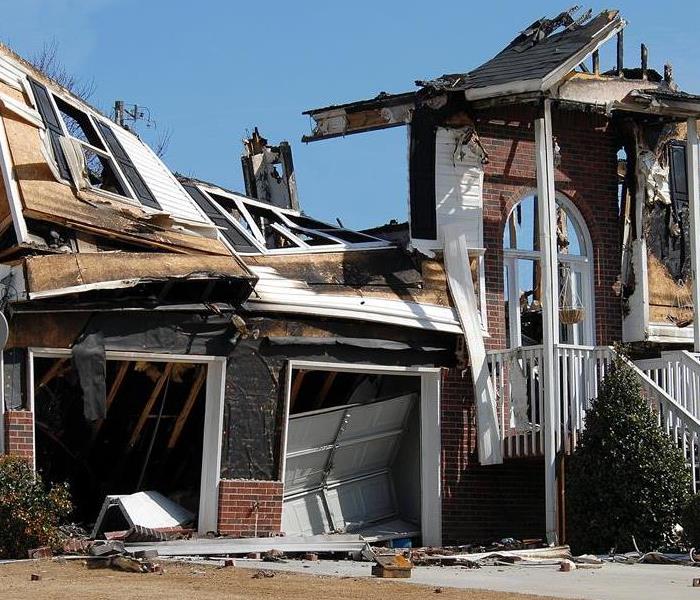 A home severely damaged by a fire.
A home severely damaged by a fire.
When a fire happens you expect a quick response from the fire department. But what happens once the fire is extinguished? The fire department does what they can to minimize damage to "exposure areas" but their responsibility ends once the fire is extinguished.
You will need a restoration company to intervene quickly to minimize damage. To that end, we respond as quickly as possible to be able to assist the owner in navigating the process. This sometimes leads to an awkward situation where owners are confused about why we are there and what they should do. I've personally had people react negatively as they perceive our quick response as a way to make a buck. While I understand this perception, and we are a business, it is our intention to assist the owner through every step of the process in order to minimize damage, provide assurances that things will be returned to normal, and ensure that important first steps are done correctly.
If you see us at a fire scene, please understand that our mission is to assist those affected in a variety of ways and without delay. Please help us to engage with the owner and allow us to use our expertise to be a resource to them. Thank you!
Key First Steps in Fire Damage Remediation
10/29/2021 (Permalink)
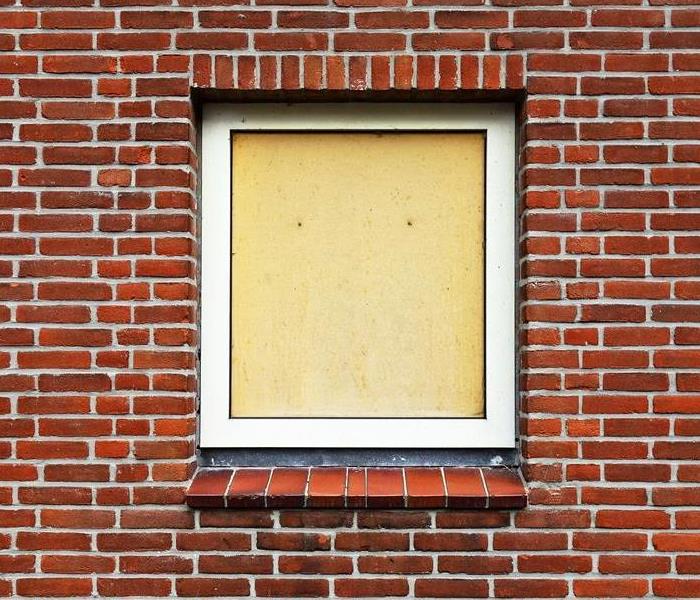 A boarded-up window.
A boarded-up window.
In a prior post, I spoke about our rapid response to a fire scene and our purpose for being there, often before the fire department leaves. Below I will touch upon some of the critical actions we take when we connect with the owner.
First, we provide assurance that we will be with them throughout the process. This includes facilitating communication between the owner and the insurance company as well as third-party adjusters. We use the same estimating software that is used by insurers to accurately document and detail what services are needed to reduce the possibility that claims will be questioned down the road.
Second, we look to secure the scene. Firefighters may have removed doors and are trained to "turn windows into doorways" as a way to provide both evacuation routes and ventilate the structure. quick board-up is needed to prevent additional damage and prevent unauthorized entry.
Third, we look to identify and remove belongings that need special attention and storage at our offsite facilities. This may include precious items, family heirlooms, and keepsakes.
Forth, we look to immediately begin extracting water to prevent further saturation and limit mold growth.
From here a detailed remediation plan is developed with consideration for the eventual reconstruction phase of the project. While we work with clients throughout the process, our early interventions are essential in limiting the overall cost and scope of the project.
Prevent a Dryer Fire
4/28/2021 (Permalink)
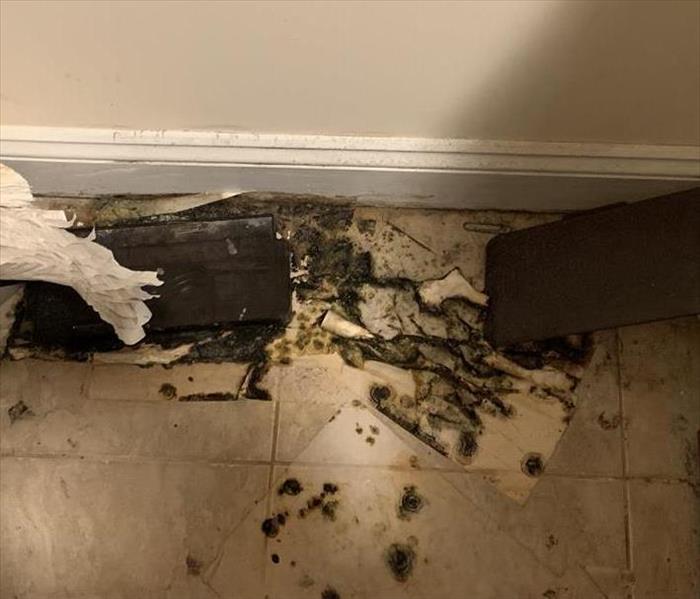 Burnt material behind a dryer that fortunately did not create a larger fire.
Burnt material behind a dryer that fortunately did not create a larger fire.
Dryer fires are a serious issue that causes thousands of fires in the US each year. Clogged vents can easily cause the lint buildup to ignite and quickly spread to the surrounding areas. The homeowner in the attached photo was extremely lucky that the buildup behind the dryer ignited but the fire did not spread to the surrounding material causing a structure fire.
Dirty or clogged dryer vents and ductwork reduce your dryer’s performance and efficiency. However, the buildup of heat, dryer lint, and dust can lead to a fire hazard. It is recommended that dryer ducts and vents be cleaned annually to keep your units running efficiently and safely.
If you have not cleaned your ducts/vents recently, and especially if you are experiencing any of the following warning signs, call SERVPRO today.
Warning signs:
- laundry taking longer to dry
- the clothes dryer becoming hotter to the touch
- a burning smell becoming noticeable in the laundry room.
Call SERVPRO today!
Gas Safety - Part 1
3/31/2021 (Permalink)
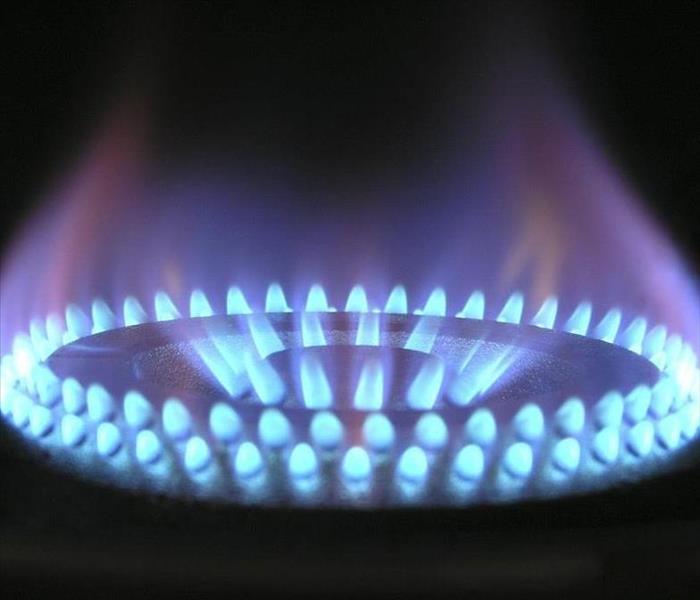 A Gas Burner Burning
A Gas Burner Burning
This month marks the anniversary of the 1994 Durham Woods gas pipeline explosion in Edison, NJ. This sudden explosion of a 36-inch gas pipeline was caused by minor damage from a backhoe years earlier that slowly deteriorated the pipe until it ruptured causing a ball of flame and mushroom cloud so large that one pilot flying into Newark Airport reported it as a nuclear blast.
Fortunately, these incidents are very rare. However, more mundane gas (propane or Natural gas) incidents are very common and are easily managed if you know what to do. First, call 911. This article is not intended to teach you what to do as an alternative to calling for professional assistance. The fire department and gas companies are very willing to come and help. Beyond their level of training, they have specialized tools that you won’t find in your toolbox.
Tips to prevent a gas fire/incident:
- Make sure all appliances that use Gas including furnaces, ovens, dryers, fireplaces, grills, etc. each have shut off valves that are easily accessible and functional.
- Download the SERVPRO Emergency Response Plan App and document the location of valves so you can easily share the info with friends/neighbors/first responders if you are not home.
- Have gas appliances serviced annually. Consider a service plan from PSE&G or NJNG which are a great value.
Gas Safety - Part 2
3/31/2021 (Permalink)
 This shut off valve is located just before the regulator (the saucer-like disk).
This shut off valve is located just before the regulator (the saucer-like disk).
Natural Gas is non-toxic. It is also naturally odorless but a chemical called mercaptan is added to give it the distinct rotten eggs smell. If you smell gas in your home, call 911. You should leave the house and wait for first responders at this point. But, if you are like me and feel the leak is minor and want to address it here are some tips.
- Don’t turn on any lights or create any ignition sources.
- If the leak is coming from an appliance such as a stove or clothes dryer, see if there is a shut off valve to the unit and turn the valve handle so it is perpendicular to the pipe.
- If the leak is stopped and you want to ventilate the structure remember that natural gas is lighter than air and will float to upper floors while propane is heavier than air and will flow downstairs.
- If the leak is significant and not able to be stopped at a remote valve, the main gas line can be turned off where it enters the house. Typically a pipe comes out of the ground and runs through a regulator and meter before entering the house. There is usually a valve on the pipe before it reaches the regulator (the disk-like piece). This will turn off all of the gas to your home but will require a plumber to resume service.
- Use caution when digging. You can call 811 and have the utility companies mark their connections for free. Gas lines are plastic and can be punctured with a good shot from a spade shovel. These lines are only required to be a foot below ground and usually go straight from the gas connection to the street.
If the possible source is not obvious wait for the first responders. They have meters to test the overall gas levels in the building as well as “sniffers” that can pinpoint the exact location of the leak. They will attempt to isolate the leak and minimize the impact on your home/business until your plumber can make the repair.
Is Your Smoke Detector Working?
2/25/2021 (Permalink)
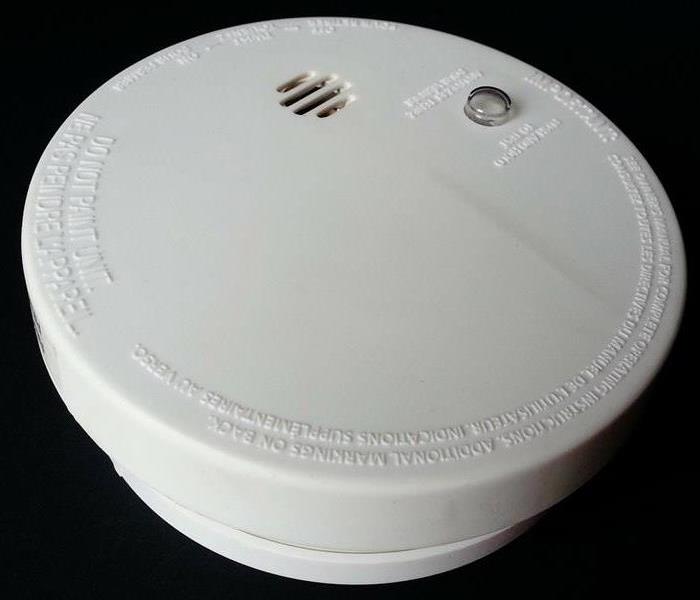 A typical smoke detector
A typical smoke detector
Are your smoke detectors working correctly? In many homes and businesses the answer is no. Often the problem is that they are perceived as a hassle and there are too many false alarms. The information below will help you troubleshoot your system because the simple fact is that smoke detectors save lives and prevent property damage.
All too often the answer for property owners is to disable the system to avoid the nuisance alarms. The batteries are removed, the system is disabled, or the devices are removed entirely. This is usually undetected, especially in private homes where fire officials do not perform regular inspections and have limited enforcement powers.
There are 3 basic types of systems but the tips below are largely the same for each. Single station units are the ones you buy at the hardware store and screw to the ceiling.
Hardwired/interconnected may look the same but they activate as a group ensuring that all areas of the home get the message. These first 2 types only notify the occupants. Monitored systems may be wired or wireless but they notify the fire department when activated.
The smoke detectors themselves are typically one of 2 types: Ionization or photoelectric. Ionization units use a small amount of radioactive material that detects invisible particles created by the fire using electrical currents. They are more expense so most people have photoelectric units. Photoelectric units use a beam of light which is deflected by smoke particles to activate.
The main problem is that other “stuff” can enter the chamber, block the light, and set off an alarm. This includes dust and bugs. The most common unwanted cause of activation is a contractor sanding near the unit. This is easily identifiable but a little spider passing through often makes the owner think the device malfunctioned.
To prevent issues follow these tips:
- Cover the detector when working nearby, especially sanding
- Put a monitored alarm system on test if you are doing something that may activate the system
- Change your batteries each time you change the clocks
- Use a vacuum to clean the unit periodically
- Units have a manufacture date on the back of them and they expire after 7-10 years depending on the brand. Replace them when needed.
Whatever you do, don’t disable these important systems. The fire department would much rather respond and find a minor issue than fight a significant fire because your system was disabled. Your local fire department is most likely offering a complementary home safety survey which can answer any questions you have along with other helpful advice.
Grab the Fire Extinguisher
1/28/2021 (Permalink)
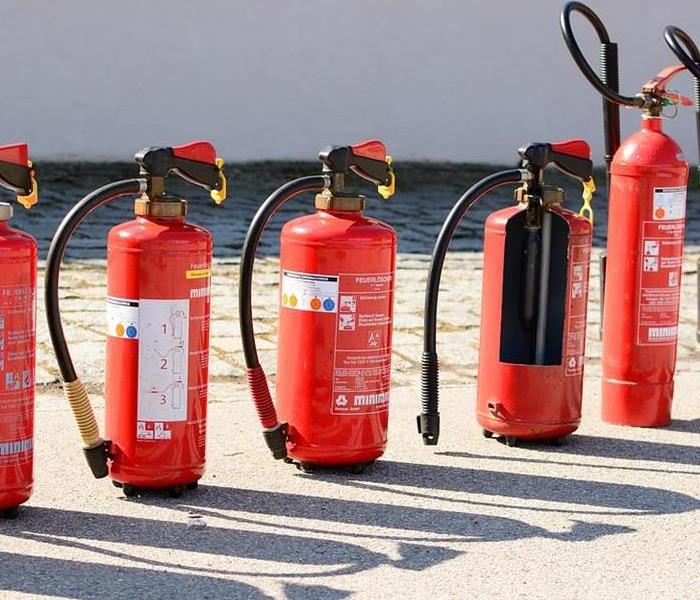 Several Types of Fire Extinguishers
Several Types of Fire Extinguishers
One of the most obvious things you can do to limit fire damage is to extinguish the fire quickly. However, some of the most common causes of residential fires are Cooking (48%), Heating appliances (14%), and Electrical malfunctions (14%), and these are not safely or effectively extinguished with water.
I am a firefighter and last night we had a call at 4AM caused by an electrical outlet which was sparking and catching the wall on fire. These calls are very routine. As a homeowner, you do not want to spray water on an electrical outlet due to the risk of electrical shock. YOU NEED TO HAVE A FIRE EXTINGUISHER IN YOUR HOME!
Fire extinguishers come in a variety of types based on the classification of fire they are designed to extinguish. For home use you should have a class ABC extinguisher which means is can extinguish class A fires (solid materials like wood), class B fires (liquids like gasoline or oil), and class C fires (electrical equipment).
Most towns require at least 1 extinguisher under the kitchen sink in order to obtain a certificate of occupancy to sell a home but these tend to disappear over time. Personally, I keep one under the sink, one on the wall in the laundry room, and one in the garage. At least maintain the class ABC extinguisher under your kitchen sink at a minimum.
If you do experience a fire, call the professionals at SERVPRO to help restore your home, “Like it never even happened.”
Proper Soot Remediation
1/21/2021 (Permalink)
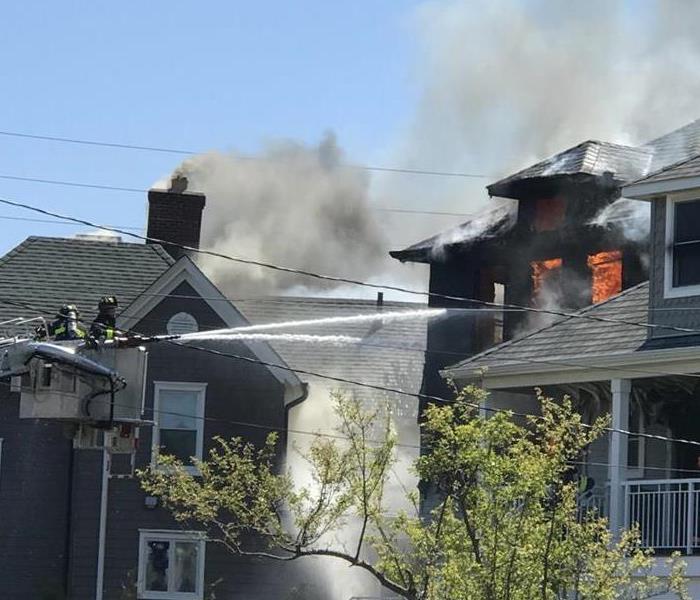 Smoke Coming From a Burning Home
Smoke Coming From a Burning Home
The possible health effects of a fire can last long after the flames are extinguished. In fact, decontamination of soot and environmental exposures is the “hottest” topic in the fire service today. The nasty chemicals caused by fire can linger for long periods of time on surfaces and in belongings. Make sure these items are professionally cleaned.
Soot is made of tiny particles created by incomplete combustion, technically called pyrolysis. (Fun fact: solids and liquids can’t burn. Heat at the surface of these materials is converting them to gasses which burn.) Even the basic wood used in framing (Douglas Fur) causes 75 different chemicals including poisons such as hydrogen cyanide and phosgene. These particles linger in the form of soot leaving a dangerous smelly mess.
During a fire, soot spreads to the whole house, attaching to surfaces. The acidic properties of soot can further damage your home and indoor air quality if the soot is not removed immediately.
Soot can inhabit your home even without a fire. Candles can lead to soot buildup, fireplaces can release soot as well if not ventilated properly, and furnaces are also a source of soot contamination when they produce a puff back (reference our blog on puff backs at What is a Puff Back?)
To avoid the health risks of soot exposure after a home fire, make sure that all soot-affected areas are properly cleaned and sanitized.
When cleaning soot, wearing safety equipment to protect the lungs, skin, and eyes is essential in reducing soot exposure. Specialized techniques such as air scrubbing are also needed to restore indoor air quality following a fire.
A dust mask and a household cleaner are not enough to clean up soot! Removing soot requires professional tools, knowledge, and expertise. Certified experts at SERVPRO can properly clean soot and odors from your entire home to ensure it is safe to inhabit.
If you are concerned about these exposures in your home, call us today for a consultation at 201-330-4193.
Do Small Home Fires in Little Ferry Need Professional Restoration Services?
10/24/2020 (Permalink)
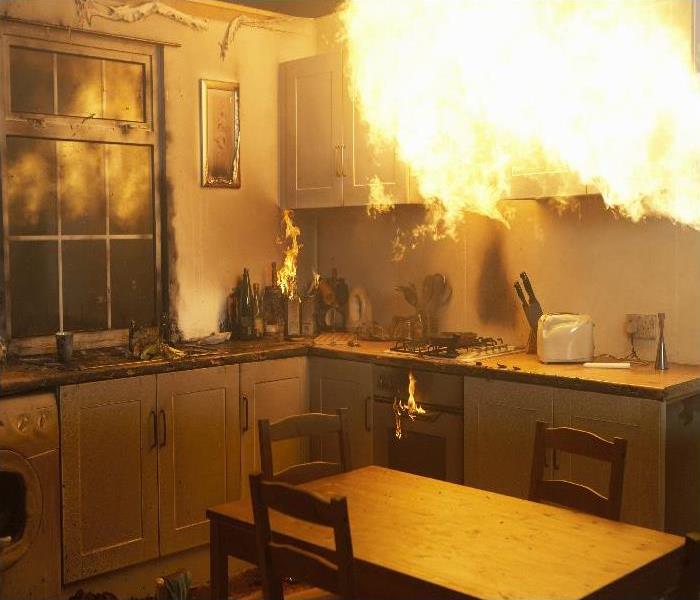 SERVPRO of Hackensack / Little Ferry at (201) 742-5920 stands ready 24/7 to support local properties with fire damage.
SERVPRO of Hackensack / Little Ferry at (201) 742-5920 stands ready 24/7 to support local properties with fire damage.
Soot and smoke damage can spread throughout your Little Ferry home quickly, so bringing in SERVPRO to halt the issue should be priority number one
When a small exterior fire or a kitchen blaze that did minimal damage in a Little Ferry home occurs, the first impulse many homeowners have is to clean up the mess and replace the siding or sheetrock that received charring. However, in many cases, this works against the property owner because the fire odor remains as the soot and smoke residues did not get adequately removed. Some of the main issues with soot remaining in the home are:
• Soot particles can exist smaller than the eye can see and produce pungent odors anywhere they are in the home
• This particulate can get spread through the ductwork and foot traffic in the home
• Soot can be a potential skin and respiratory irritant for some people
• If not removed quickly, soot can pit and mar chrome and metal fixtures
What is the Best Method to Remove Fire Damage?
When SERVPRO techs clean up and restore Little Ferry homes with fire damage, the equipment and applications used depend on the type of smoke damage left behind; there is no single "best method." Dry smoke does not cling to surfaces in the same manner as wet smoke residues apply themselves, requiring the use of solvent-based cleaning agents to release its grip.
Also, care needs to get taken to match the cleaning solution to the type of surface or material getting cleaned to ensure the agent chosen will not harm the article getting cleaned. That is why the SERVPRO techs give detailed attention to testing fibers and learning the manufacturing components of items before cleaning, so it gets done right for the best outcome.
SERVPRO of Hackensack / Little Ferry at (201) 742-5920 stands ready 24/7 to support local properties with fire damage. The technicians have the training and advanced tools to make the damage to your home, “Like it never even happened.”
Basics of Smoke Damage
4/6/2020 (Permalink)
Smoke damage from a fire, no matter how large or small, can be devastating. Oftentimes smoke damage can be long lasting, which is why it is so important to take care of it immediately.
Behavior of Smoke
A fire loss can be very complex because of the unique behavior of smoke. SERVPRO of Hackensack/Little Ferry undergo extensive fire restoration training and certification, and understand the behavior of smoke.
- Hot smoke migrates to cooler areas.
- Smoke migrates to upper levels of a structure.
- Smoke flows around plumbing systems, using holes around pipes to go from floor to floor.
This enables us to take care of smoke throughout the entire home or office.
Knowing how smoke penetrates and lingers is only one part of being able to mitigate smoke damage. Knowing what types of smoke will greatly affect the restoration process as well.
Types of Smoke
- Wet smoke- Plastics and Synthetics
- Low heat, smoldering, pungent odor, sticky, smeary. Smoke webs are more difficult to clean.
- Dry smoke- Paper and Wood
- Fast burning, high temperatures, dry. Powdery, non-smeary residues. Heat rises therefore the smoke rises.
- Protein Fire Residue- Produced by evaporation of material rather than from a fire.
- Virtually invisible, discolors paints and varnishes, extreme pungent odor.
- Fuel Oil Soot- Furnace Puff Backs
- While “puff backs” can create havoc for property owners, SERVPRO professionals can, in most cases, restore the contents and structure quickly.
Other smoke related services we offer are:
Content Cleaning
- Smoke and soot residues and deposits can cause permanent damage to contents and may result in periodically resurfacing odors if not properly deodorized.
- All salvageable contents in affected areas will be professionally cleaned and deodorized to preloss condition when possible. This includes area rugs, furniture, draperies, upholstery, electronics, clothing, photos, kitchen items, bedding and much more.
Deodorization
- SERVPRO provides specialized services
that rid structures of offensive odors left by fire or smoke damage. We do not merely cover up lingering odors with a fragrance, we seek out the sources of the odor and remove them. - Proper deodorization is vital as odors may appear to be gone, only to reappear months later under different conditions, including when humidity levels rise.
It is important to understand why calling us in the event of a fire, no matter how large or small. The professionals at SERVPRO Hackensack/Little Ferry will help get you back to your lives and jobs as soon as possible.
What to Dispose (and What to Keep) After Fire Damage
3/4/2020 (Permalink)
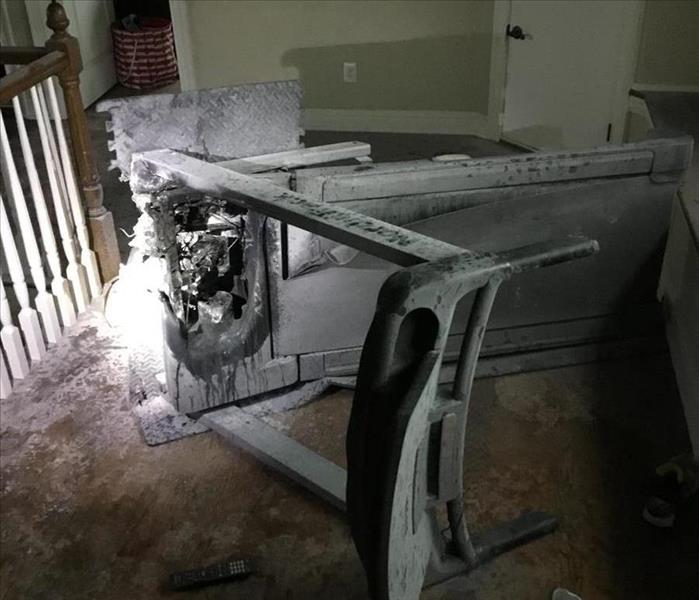 Damaged electronics such as a treadmill pictured above is an example of something that should be desposed after a fire.
Damaged electronics such as a treadmill pictured above is an example of something that should be desposed after a fire.
Fires can be devastating to a home or business, potentially damaging everything in their wake.
If your home or business suffers a fire, you should definitely throw out anything that has been melted, burned, or otherwise visibly damaged by the flames, heat, and/or smoke.
However, sometimes, it’s difficult to tell what can be salvaged and what should simply be tossed. Here is a quick guide to help you start to make decisions as you cleanup from a fire.
Four items you should definitely throw away:
Food Exposed to Fire and Heat
- Any foods that come contact with the flames, smoke, high heat, or firefighting substances (especially if the packaging was already opened).
- Foods stored in the refrigerator or freezer if the temperatures reached higher than 40 degrees Fahrenheit for longer than 2 hours.
- If smoke, soot, or fire entered the refrigerator/freezer, just stay on the safe side and toss everything.
Fabrics
- Any clothing, bedding, carpeting or other fabric that has sustained major burning should just be disposed.
- Anything charred or significantly burned.
Mattresses
Mattresses that have been stained or burned by fire should just be disposed as they may now be structurally unsafe and/or carry contaminants.
Medicine and Cosmetics
- If prescription medicines have been affected by a fire, you should contact your doctor immediately.
- It’s best to replace them as you don’t want to risk becoming sicker from potential contamination.
Three examples of items that can often be salvaged after a fire.
Hardwood
Luckily, hardwood floors can often be saved, unless there is extreme burning or charring.
You can often use an oil soap made especially for wood to clean off stains, and then sand and refinish your hardwood to restore it.
Glass
Glass, if it doesn’t melt, is often resilient to fires.
If your glass is simply stained, try cleaning it with white vinegar or dish soap. You can also try to soak it in vinegar and baking soda.
Metal
Metal may stain, but often can withstand the heat and flames.
To clean mental, use vinegar or dish soap and then try to gently sand and paint the metal.
Note: never try to keep items that may be melted, charred, or rendered structurally unsafe.
If you need help trying to salvage and/or restore your property and belongings after a fire, our team of experts here at SERVPRO Hackensack / Little Ferry is close by and ready to help! Whatever the size of your fire damage, we have the know-how, training, and tools to help you deal with it and move forward.
5 of the Most Important Winter Fire Safety Tips You Need to Know
2/26/2020 (Permalink)
These are the days of the year when we expect temperatures to remain chilly if not freezing, and it’s common for use multiple heating sources to keep your house warm. Unfortunately, that means it’s also a time when there’s a greater risk of fire damage.
Too many homes suffer from fire damage that could have been prevented with just a little foresight and planning. In order to help you keep your family safe from fire during the cold weather days, here are 5 of the most important Winter Fire Safety Tips you should act on:
Check Your Smoke Alarms
Ideally, you would have checked your smoke alarm batteries when the clocks changed. But now is the season when it might actually make a difference, so make sure that your batteries are good for the Winter.
Also, there should be smoke alarms in every bedroom plus the kitchen and laundry room at bare minimum. Make sure you have enough smoke alarms strategically placed all around your home.
Inspect Your Chimney
If you use a fireplace, you should know that they can produce creosote, which is a flammable substance.
If your family likes to light fires in the fireplace, you should get an annual chimney inspection to ensure there are no fire hazards. And remember to use dry, seasoned wood.
Always Use a Screen for Your Fireplace
Whether you prefer a metal screen or a screen of tempered glass, you want to make sure to protect against any sparks that might otherwise stray from the fireplace.
Even with a screen in place, be sure to keep curious children and pets safely away from the fireplace. Also, any potentially flammable fabrics or materials should be kept at least three feet away from a lit fire.
Maintain Your Furnace
Typically, it’s a good idea to invest in an annual inspection from a professional. They can check your system for the signs of wear and tear or potential damage that could lead to furnace problems.
Use Candles and Space Heaters with Caution
Make sure they are placed securely where they won’t get knocked over, as well as safe out of the reach of young children and pets.
And don’t forget to blow them out when you leave the room!
Similarly, with space heaters, you want to make sure to keep sufficient clear space around them (typically at least 3 feet all the way around) to prevent a potential fire hazard. Make sure the fire heater you use has an automatic shut-off switch so that its internal mechanisms won’t overheat. Make sure to turn it off before you go to sleep or move to a different room.
Here at SERVPRO of Hackensack/Little Ferry, we have a strong track record of protecting the people and properties of this community from the trauma of fire damage. We’re known not only for our reliability and expertise as a professional restoration and cleaning services provider, but people love us for our friendly customer service too.
Fire Damage Hazards: What You Need to Know About Smoke and Soot Health Risks
1/15/2020 (Permalink)
If your home or commercial building has been the victim fire damage, some of the most significant health risks you need to consider come from smoke and soot. While it’s obvious that smoke and soot stains need to be cleaned up after a fire, too few people stop to consider the potential health risks.
As leading experts in fire damage restoration in this community, our team at SERVPRO of Hackensack/Little Ferry wants to make sure everyone knows the hazards – and precautionary measures – just in case your home or business is ever damaged by fire.
Here’s what you need to know about the health risks of smoke and soot:
Why Smoke and Soot Are Dangerous
Our homes and commercial building are made up of a variety of materials. While these materials are generally safe under normal conditions, a fire can cause their chemical components to change, many times releasing potentially harmful chemical compounds into the air.
In the form of smoke and soot, dangerous chemicals can quickly spread and affect the far reaches of your property. These chemicals are hazardous to inhale during a fire, and can still be hazardous days or even weeks later.
Common Toxins in Smoke and Soot
Three of the most dangerous chemical compounds after a fire are carbon monoxide, hydrogen sulfide, and hydrogen chloride:
- Carbon Monoxide – carbon is a common component of various building materials, and when carbon burns it can release carbon monoxide into the air.
- Hydrogen Sulfide – some types of building materials, for example those containing oil or coal, can release hydrogen sulfide gas into the air when burned. Exposure to this gas can irritate your respiratory system and even lead to pulmonary edema.
- Hydrogen Chloride – PVC materials when burned are known to release hydrogen chloride among other hazardous chemicals. In a gas state, hydrochloric acid can burn the mucous membranes of your lungs. In a liquid state, it can burn skin and cause permanent blindness if it comes in contact with your eyes.
Symptoms of Smoke and Soot Exposure
The most common symptoms of exposure to soot and smoke are:
- irritated eyes, lungs, and noses.
- congestion, shortness of breath, or other respiratory problems.
- headaches nausea, disorientation, and balance problems.
- skin rashes or burns if you come in direct contact with certain sooty materials.
How to Prevent Smoke and Soot Health Risks
The best way you can limit the health risks associated with soot and smoke is to make sure your fire damaged property is properly and thoroughly cleaned.
The proper clean-up process after fire damage includes sanitizing the area as well as cleaning the ducts of your heating and cooling systems.
If you’re interested to learn more about professional cleanup and restoration after a fire, SERVPRO of Hackensack/Little Ferry will be happy to answer any questions you have.
Clean Your Home After A Fire
11/22/2019 (Permalink)
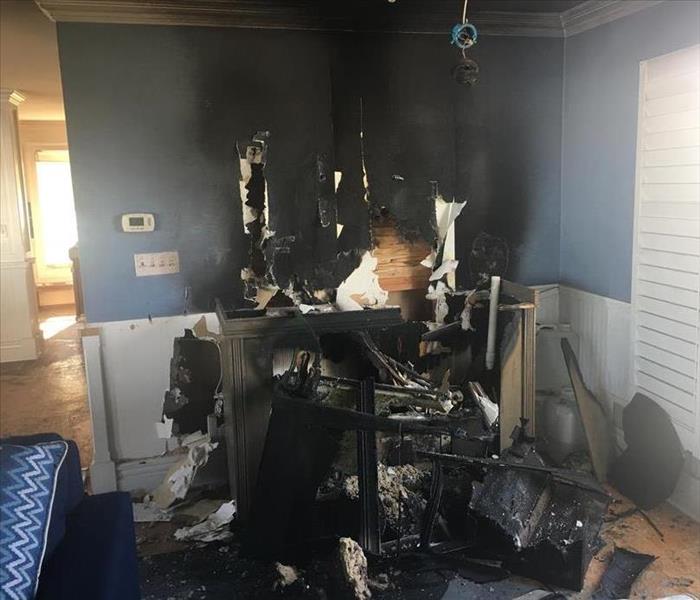 Cleaning up after a fire can be devastating and overwhelming. SERVPRO of Hackensack/Little Ferry can help and make the process less stressful.
Cleaning up after a fire can be devastating and overwhelming. SERVPRO of Hackensack/Little Ferry can help and make the process less stressful.
If you’ve experienced fire damage in your home or business, you’ve undoubtedly observed that smoke and soot can unfortunately damage almost all kinds of surfaces and materials. CONTACT YOUR INSURANCE COMPANY, because in most cases, everything from cleaning to replacement is most likely covered.
The amount of soot and smoke may also be inundating, so calling SERVPRO of Hackensack /Little Ferry may help you feel less stressed and overwhelmed.
In the event that you want to start cleaning, begin as quickly as you can, in order to prevent the effects of long-term damage.
Smoke and Soot Stains from Wood
As long as your wooden items aren’t charred, you should be able to clean them with a mild oil soap. Rinse with water, and let them air dry.
Smoke and Soot Stains from Upholstery
If you can remove stained upholstery, your best bet is to bring it to a dry cleaner that specializes in cleaning fire damaged fabrics.
If you have upholstery that’s can’t be removed, vacuum the surface with a shop vac, keeping the hose just above the surface to prevent rubbing in the stain even more. Next, sprinkle the stain with baking soda and allow it to sit for at least one hour. Then, spray the stain with white vinegar and wipe with a damp rag.
For hard-to-clean stains, you may have to let the baking soda sit longer (sometimes overnight) and/or repeat the cleaning process multiple times.
Smoke and Soot Stains from Metal
Use a polish that is specially designed for the specific type of metal you have. Gently rub the stain with the polish and then wipe away with a clean rag, but be sure to follow the manufacturer’s instructions.
Smoke and Soot Stains from Glass
To clean glass, you can often use a commercial glass cleaner or a homemade solution of one-part water to one-part vinegar. You’ll want to avoid spraying the glass, as this can leave smoke streaks. Instead, apply the solution to the rag and start wiping at the edge of the stain moving inward.
Smoke and Soot Stains from Leather
You can clean fire damaged leather with a specialized leather soap and conditioner, though be sure not to get the leather too wet, as this can create additional stains.
If you need help to restore your property after fire damage, remember that SERVPRO of Hackensack/Little Ferry is always here to help.
SERVPRO Can Help You Clean-Up Smoke and Soot Damage after a Fire
7/1/2019 (Permalink)
Have you been the victim of a fire? Here a SERVPRO of Hackensack / Little Ferry, we know that every fire disaster is different. Some fires produce a lot of smoke, while others involve intense flames that leave lots of soot and ash in their wake.
Whatever kind of fire damage you’re dealing with, we know that what’s most important is that your recover as much as you can as quickly as possible.
Our team at SERVPRO of Hackensack / Little Ferry approach every scenario with a “restore first” mentality – and our specialized training and equipment makes it possible for us to restore your property to its pre-fire state as well and as quickly as is possible.
Dry
If a chemical fire extinguisher or water was used to put out your fire, we will remove any standing water and dry out the affected area as quickly as possible. Sometimes, some of the worst damage in the wake of a fire is the water damage that comes from the firefighting efforts.
Vacuum
Once everything is dry, we vacuum up as much of the ash and soot. Remember that smoke often extends further than the flames, so we make sure to clean in areas nearby to where the fire hit.
Air
Once the loose ash and soot is cleaned up, we ventilate the affected area.
Clean
It’s typical for soot and smoke to settle on surfaces in the form of an oily powder. SERVPRO specializes in and has special solutions to clean this residue from your home.
If you’re ever in need of fire damage restoration assistance, you can rest assured knowing that our team here at SERVPRO of Hackensack / Little Ferry is always close by and able to help!
Smart Home Devices Prevent Fire Damage
4/8/2019 (Permalink)
If you’re a cautious homeowner, you want to take smart measures to prevent fire damage to your home. In the 21st century, there are new Smart technologies for your home that can make these preventative measures easier than ever to manage.
SERVPRO of Hackensack / Little Ferry is committed to helping homeowners in this community keep their homes and properties safe. That’s why we love these kinds of technological advances that you can hook up to your WiFi network and smartphone to keep you and your family safe. If these devices detect something dangerous, you can get alerted right away so that you can hopefully take care of the issue before it becomes a major disaster
Here smart home devices that can help you prevent fire damage to your home and property:
Smart Fire Detectors and Smart Smoke Alarms
You can set up these cutting-edge fire detectors so that they will automatically send an alert to your smartphone if the temperature reaches a certain point or if there’s a sudden rapid rise in temperature. These devices can even be connected to your centralized security system for greater precision and control.
You can also get Smart alarms that detect smoke or carbon monoxide. Some of these devices will even shut down your HVAC system if smoke is detected to prevent further complications. If you connect these devices with a Smart security system, they can also automatically alert the fire department in case of emergency, no need for anyone to have to dial 9-1-1.
Smart Electrical Outlets
These are outlets that you can turn off remotely using an app on your smartphone. This can be good protection in case you’re worried you forgot to shut off lights or appliances.
Some of these outlets can even be controlled by voice commands when you are home, so that you can turn off electricity even from another room.
Smart Batteries
If you’re the kind of person who has a tendency to forget to change the batteries in your smoke alarms, you may want to invest in Smart batteries.
Most of these batteries are compatible with multiple kinds of alarms and detectors, and they will send you an alert when the battery gets low.
Smart Kitchen Shut-Off Devices
Kitchen fires are a leading cause of fire damage to homes. These Smart devices can help prevent such fires by automatically turning off the oven or stovetop.
These Smart devices are typically motion sensors that are installed to a kitchen cabinet. If you leave the kitchen, the device will start a timer, and if you don’t return before the timer counts down, the device will automatically shut off your oven.
All this 21-st century tech can go a long way to helping you keep your home and family safe. If, however, you do experience water or fire damage, know that SERVPRO of Hackensack / Little Ferry is always here to help. We have all the advanced equipment, training, and knowledge needed to restore your property ASAP.
How We Can Help After a Fire
2/27/2019 (Permalink)
Having a fire in your home is a devastating and traumatic experience. No matter how small, soot, smoke and ash can creep into every crevice of your home, leaving a fine film over surfaces, ash everywhere and a lingering odor. It is easy to feel overwhelmed and not know where to turn to or whom to ask for help.
Having a fire in a structure next to your home can be just as devastating, as fire may destroy siding, smoke and ash may enter your home and water used to put out the fire next door can also affect rooms in your home as well. It can be just as traumatic not knowing what to do or whom to turn to.
SERVPRO of Hackensack/Little Ferry is here to help. We have certified, experienced and professional technicians who will come to clean and deodorize – finding every place soot and odor can hide. We are also experts in content cleaning like furniture and have services that can clean documents, photos, artwork, rugs and window treatments. We can tarp your home where damage has occurred or board up windows and doors if needed.
Whether you experience a fire in your home or are affected by one next to you, remember that SERVPRO is here to help, and truly can make it “Like it never even happened.”
The Danger of Fire Damage During the Winter Season
1/29/2019 (Permalink)
More fires occur during the winter months than any other time of the year. During the cold weather season, people tend to find extra ways to keep warm. Unfortunately, many alternative heating methods can also be fire hazards, especially when caution is not used.
To prevent fire damage during this cold weather season, here are 4 things to keep in mind:
Fireplaces and Wood Burning Stoves
Here are some precautions you can take to keep your fireplace or wood burning stove safe:
- Shield the fireplace with a grate to prevent flying sparks from igniting in the room.
- Keep any flammable materials at least 4 feet away from the fire place.
- Perform regular maintenance and cleaning on your fireplace and/or wood burning stove.
- Make sure there are no cracks in your chimney and that the top is properly capped to keep out debris throughout the year.
Space Heaters
Here are some general rules to follow for safe space heater use:
- Use only space heaters with a “tip switch,” ones that shut off automatically if tipped over.
- Make sure to follow the manufacturer’s safety instructions.
- Keep the space heater at least 3 feet away from anything flammable.
- Make sure there is adequate ventilation and base/floor support in the areas where you will use a space heater.
Electric Blankets
Here’s what you need to know about electric blanket safety:
- Check for charred or frayed cords or any dark spots, these may indicate a potential problem with the electrical element.
- Don’t allow anyone or anything on top of the blanket when it is in use, this could lead to overheating.
- Similarly, don’t fold or tuck in the blanket when it is in use, as this could also lead to overheating.
- An electric blanket should never be left unattended or used while one is sleeping.
Smoke Alarms
It’s generally a good idea to regularly check the alarms each year. It’s also wise to double-check the alarms before you start a fire or use a heating element, just in case.
Here at SERVPRO of Hackensack/Little Ferry we pride ourselves in being community leaders in both fire prevention and fire damage restoration. Our company is not only locally owned and operated, we’re also part of a nation-wide network of franchises with specialized Disaster Recovery Teams that handle fire catastrophes. We know how devastating a fire can be – and, unfortunately, the tips for prevention are often not talked about as much as they should be. We want to help change that.
How To Keep Your Home Safe From Fire This Winter
1/15/2019 (Permalink)
Properly using and caring for your heating equipment in your home is paramount in order to prevent a fire emergency from happening.
Remember these tips that can help keep you and your family safe from winter fire damage.
Check Your Alarms
Make sure you have both smoke and carbon monoxide alarms installed throughout your home, especially in and near the rooms where you will be using additional heating. Test to see if they are in working order. otherwise replace it right away.
Have your furnace serviced every year.
To keep your furnace burning cleanly and proficiently, it is important to have yearly maintenance performed. Not only will this insure that your furnace is performing at its maximum capacity, it may help extend the life, saving you money in the long run.
Never Leave a Fire or Heater Unattended
Keep carpets, drapes, furniture and all other combustible items away from fireplaces and space heaters while they are in use. Use a firescreen to keep small children and pets away from fireplace flames, and watch to make sure sparks are not projected toward anything that could catch on fire.
Remember to turn off space heaters when you are not in the room, and don’t leave them on while everyone in the house is asleep. If something should go wrong, you want to be present and alert.
Test the Safety of Your Fireplace
Have your fireplace flue cleaned before each season, especially if you use it a lot. You can also test your fireplace safety by lighting just a few tiny pieces of seasoned wood. If the smoke goes out into the room instead of up and out the chimney, then you know there is a problem.
Some common fireplace problems include soot build-up, chimney debris including animal nests, and dampers that are closed or even partially closed. To prevent smoke and fire damage, you want to be sure your chimney is open and ventilating properly.
Burn Only Seasoned Wood
If you’re using a fireplace or potbelly stove, you want to make sure you are using only seasoned wood as greenwood does not burn efficiently and can create problems in your fireplace or stove.
Seasoned wood is wood that has been cut and left to dry under cover for at least 6 months to a year. Hardwoods, such as maple, oak, and ash are dense and generally best for producing more heat.
Keeping your home safe is simple just by following common sense safety. However, should you ever need fire damage restoration assistance, remember that SERVPRO Hackensack / Little Ferry is always here to help!
Holiday Cooking Safey
11/23/2018 (Permalink)
The holiday season is upon us and it's a time when most people are busy getting their homes ready for large family dinners, guests and celebrations. With all that goes behind getting your house in perfect holiday order, it’s easy to get distracted and forget about safety. Here are some tips to remember while you cook that perfect holiday meal! Cooking is the No. 1 home fire hazard, according to the National Fire Protection Association.
- Always stay in the kitchen when cooking, and always keep an eye on the stove, oven or grill.
- Be careful of smoking oil – that is a sign that the oil is too hot and may ignite. Lower the flame or remove the pan from the heat.
- Never try to put out a pan fire with water. Baking soda works to extinguish a pan fire.
- It is now New Jersey law that every home must have a fire extinguisher within 10 feet of the kitchen area,
- Keep oven mitts, dish towels and other flammable items away from heating elements and open flames.
This family was lucky and the only casualty was the stove. We hope that during this holiday season everyone practices safety in the kitchen. If you do need our services, we are always a phone call away and available 24/7.
Fire Prevention Tips for the Fall Season
10/26/2018 (Permalink)
As the days begin to get shorter and cooler, it’s a good idea to remind yourself and your family about what to do to prevent fires. Although fire prevention safety tips are important during every season, they’re particularly important this time of year.
Here are 4 tips to help you and your family stay safe from fire dangers as the Fall season progresses:
Check Your Smoke Detectors
It’s a good habit to change the batteries in both your smoke and carbon monoxide detectors every Fall and Spring, when we change the clocks for daylight savings. This year, we will “fall back” on November 4th.
Check Your Fireplace
Once it starts getting chilly outside, families love to spend quality time around a fireplace. Make sure yours will be safe throughout the colder months!
When it comes to fireplace safety, don’t forget these 3 important general rules:
- NEVER leave your fireplace fire unattended
- NEVER use gasoline to start or tend your fire
- NEVER leave combustible materials within 3 feet of the fireplace
Early Fall is also a good time to do a yearly inspection of your fireplace for safety.
Check Your Heating System and Devices
Early Fall is also a good time of year to inspect your home heating system and any heating devices you plan to use in the coming months.
When it comes to safety tips for space heaters, don’t forget these 3 important precautions:
- Make sure to leave at least 3 feet of empty space around the space heater.
- Avoid storing or leaving any combustible items near the heater, especially clothing and draperies.
- Be sure to turn off your space heater when you go to bed or leave the house.
Check Your Yard for Falling Leaves and Other Debris
As the leaves begin to turn colors and fall off the trees, it is good to be especially cautious regarding fire prevention.
Make sure to clear your gutters and roof top from the build-up of leaves, pine needles, and other outdoor debris as these could become combustible.
Fire accidents are common this time of year. If your home suffers any fire damage, you can count on the professionals of your local SERVPRO of Hackensack /Little Ferry to help you through any difficulties. Our certified trained technicians have the advanced knowledge and technological equipment to handle any fire damage, and we can quickly restore your home back to normal. We’re available 24/7 for any emergency help





 24/7 Emergency Service
24/7 Emergency Service













